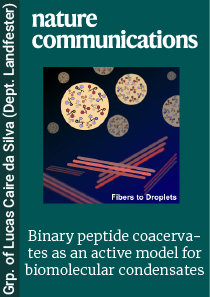Binary peptide coacervates as an active model for biomolecular condensates
Short peptide mixtures self-assemble into stable, liquid coacervate "organelles" that can sequester catalysts, undergo liquid-to-solid transitions on demand, and even compute chemical logic. By linking two diphenylalanine-based tripeptides, the researchers created programmable droplets that remain liquid (rather than turning into rigid fibers), respond to pH, heat, redox cues, or solvents, and enhance transition metal catalysis in water. Nested inside a larger complex coacervate "cell," these peptide droplets act as subcompartments that perform OR and AND logic operations, bringing synthetic cells a step closer to lifelike adaptability.

Eukaryotic cells rely on membraneless condensates to organize crowded chemistry with exquisite spatiotemporal control. To mimic this behavior with minimal building blocks, we report in Nature Communications the design of binary peptide coacervates (BPCs) formed by mixing two diphenylalanine-derived tripeptides. Unlike single-peptide systems, which rapidly form rigid fiber-like materials, the mixed droplets remain liquid for days because the heterogeneous sequence distribution weakens the intermolecular hydrogen bonding networks that drive the liquid-to-solid transition.
BPCs are highly dynamic and multi-responsive. They dissolve and reform via pH cycling, reversible heating, organic solvent exchange, or mild H₂O₂ oxidation. Molecular dynamics simulations confirm a lower aggregation tendency and fewer hydrogen bonds compared to single-component assemblies, explaining their long-lived fluidity. The droplets concentrate a wide range of guests, from proteins to hydrophobic dyes and transition metal catalysts, resulting in microreactors that accelerate ruthenium-mediated deallylation and Cu-catalyzed azide-alkyne cycloaddition in fully aqueous media.
Multi-compartment artificial cells were created by encapsulating BPCs in a polyelectrolyte complex coacervate and coating them with a nanoparticle membrane. Here, peptide droplets disassemble based on chemical cues, resulting in compartmentalized systems that allow chemical reactions and compartment structure to be controlled in a manner similar to Boolean logic gates. These programmable minimal coacervates provide a versatile platform for studying phase separation, engineering bioorthogonal catalysis, and building synthetic cells.












